Best Desk Stretches: Boost Your Workday with Easy Exercises
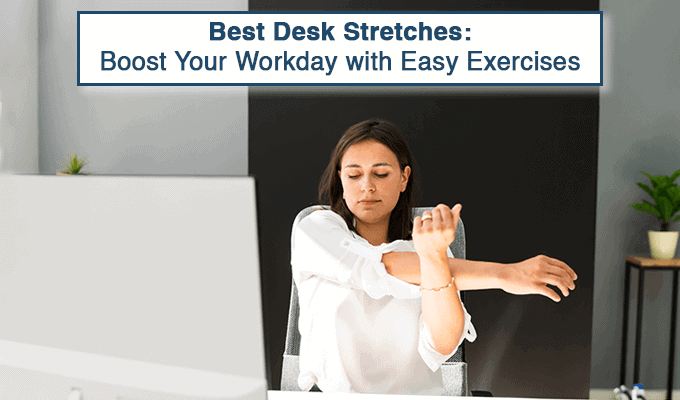
Two hours in your office, and you start feeling low, lazy, and stiff. Stretching out your legs and knees to get up becomes difficult. But do you wonder why this happens so often?
These days the work happens with just a click on the laptop. Everything has become so easy and convenient. More convenience at work makes you more sedentary. Sitting for long hours at a stretch makes your body stiff, muscles sore, and the glutes and hamstring tight, leading to all the aches and pains in the body. Long exposure to screen and sitting position leads to postural deformities, which can be hazardous if not treated on time.
Contents
A] Side effects of desk job
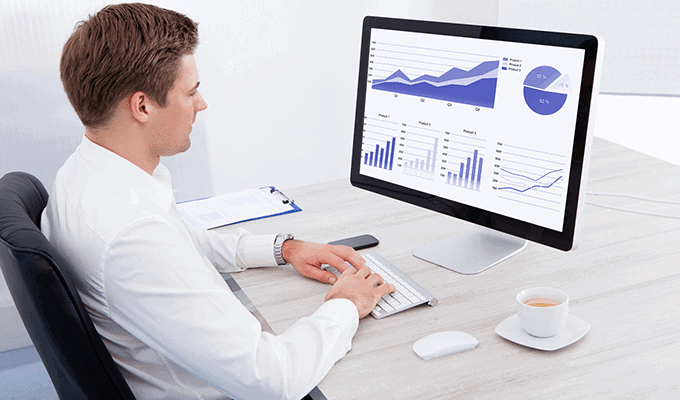
- Weight gain: With long sitting hours, there is minimal activity throughout the day. When you’re engrossed in work, you tend to eat more frequently. The calories burnt are less than what you consume, leading to weight gain.
- Lifestyle-related illnesses: Excessive weight gain can make you prone to obesity and lifestyle-related disorders like diabetes, hypertension, metabolic syndrome, dyslipidaemia, etc.
- Stiffness of the spine: Sitting for long compresses the spine.The muscles around the spine contract and relax when you change position or get up and move, causing spine stiffness. Bending forward, bending down, and twisting becomes very painful.
- Muscle weakness: While you sit, you do not use the majority of the muscles of your body. Minimum body activity leads to a reduction in muscle cell number and size, which is known as sarcopenia. There is a waste of muscles, making you feel weak.
- Joint pain: Your sitting position, constantly working on a laptop, and long hours of using the keyboard and mouse lead to inflammation in the joints. Flexion and relaxation of joints become very painful even at rest.
- Postural deformities: At times to sit comfortably, you tend to slump your back, the laptop position is at the wrong angle, your knee is folded and bent on your thighs, or you sleep and work while you are at home. All these lead to postural deformities like a hump in the neck, a curve in the spine, frozen shoulder and hip joint issues.
B] How to manage the side effects?

1. Right diet: Consume food that is low in calories to help increase your metabolism and provide nutrition. If you have a habit of munching while working, you can nibble on small portions of low-calorie foods like salads, soups or protein-rich snacks.
2. Exercises: Increasing body activity will directly help in weight reduction. If you find it difficult to dedicate an entire hour to the workout or exercises, then you can perform simple desk exercises a few times a day to remain fit.
C] Office desk exercises
1. Neck stretches: For neck stretches, drop your head slowly at the back and bend it down in front. Turn your neck slowly, from left to right. Drop your head towards the shoulder on both sides. Rotate the neck clockwise and anti-clockwise.
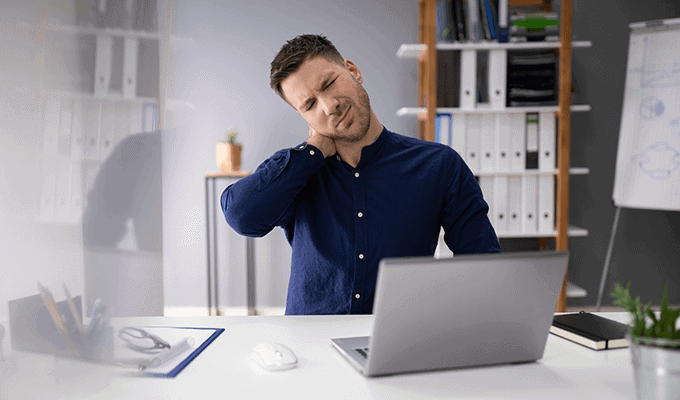
2. Shoulder stretches: Sitting erect, raise your shoulders and slowly pull them down. Move your shoulders forward and then behind. Rotate the shoulders clockwise and anti-clockwise.
3. Palm and fingers exercise: Open and stretch your fingers followed by making a fist, or join your hands in the praying position and press the palms with equal strength on both sides.
4. Whole arm exercises: Stretching out your arms along the shoulder line in front, moving them on top of your head and then bringing them back. Extend your arm on the sides keeping them straight at 180 degrees at shoulder level, and bring them down to the original position. Rotate your whole arm clockwise and anti-clockwise.
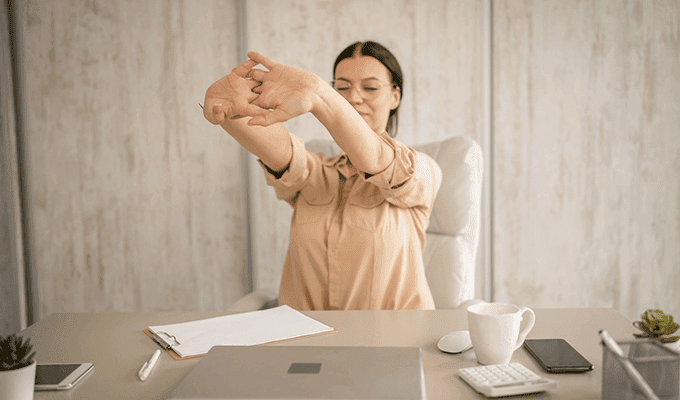
5. Back stretches: Sit erect on your chair and bend down to touch your toes. Touch your back on the backrest of the chair, bend backwards as much as possible for upper back stretch and come back to the original position. Get up from the chair, keep your legs apart in the line of the waist and rotate the back in clockwise and anti-clockwise directions.
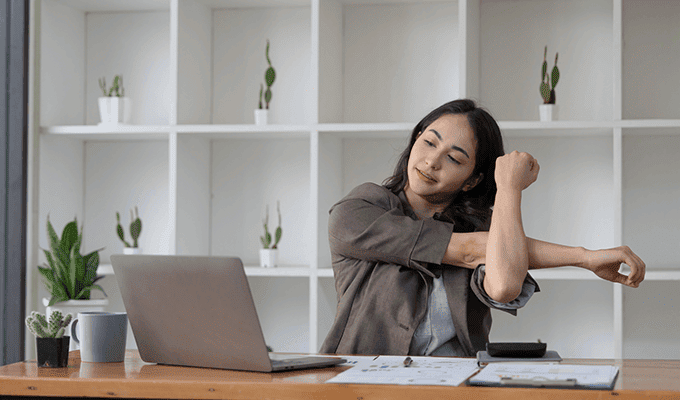
6. Hip joint opening exercises: Sit erect on the chair, touch your feet on the ground completely, and slowly lift one of your legs alternately till the maximum height you can lift. Lift your leg to maximum height, move your leg to the side as much as possible and again rest your leg in the original position. Repeat on the other side too.
7. Knee stretches: While sitting, alternately extend one of your knees in front and bring it back to the original position. Bend your knee below the chair and bring the leg back to its original position. Hold a towel roll or a small pillow between your knees, press and release.
8. Ankle stretches: Flex your ankles upwards and downwards, side to side and rotate them in clockwise and anti-clockwise directions. Curl your toes and relax them in their original position.
9. Eye exercises: Rest your eyes from constant exposure to screens, by closing the eyes for a few seconds and then opening them. Move the eyeballs from right to left, up and down and rotate them in clockwise and anti-clockwise directions.

10. Exercise with a chair and desk: Take your chair away from the desk, hold the desk and bend down keeping your head, neck, and spine at the same level as the desk. Sit erect, take your hands behind and hold the sides of the chair. Slowly, move ahead and stretch your back pulling onto the chair and relax coming back to the original position.
11. Hamstring Stretch: Stand up from the chair, extend your heel in front touching the floor and slowly bend the lower back in front. Repeat it on the other side. Perform squats and lunges if there is enough space in the office.
12. Wrist Carpal Stretches: Make a fist and rotate your wrist clockwise and anti-clockwise. Extend the hand at shoulder level in front of you and open the palm perpendicular to the ground. Push the palm backwards. Repeat with the other hand.
13. Spinal Twist: Keep your right palm on the left knee while sitting on the chair, slowly twist your spine towards the left and use the left hand as leverage while holding the chair on the extreme right. Repeat the same on another side. You can also stand near your desk, extend your arms at shoulder level and twist your spine in both directions without moving your lower body.
14. Leg Extension: Stand at your desk and raise your leg alternately in front and get it back to the original position. Stretching out your legs and knees extend your leg to the side and bring it back to the original position. Even while sitting you can extend your leg in front if you have enough leg room.
15. Calf Raise or Toes tap: Stand near your desk, feet a foot apart and slowly raise your body on your toes and relax back to the original position. Stand on the edge of the stair and move your heel downward directly stretching the calf muscles. While sitting, you can extend your knees in front and tap your toes on the floor and bring the leg in its original position.
Repeat each stretch at least ten times and hold the stretch for a few seconds for maximum benefits of exercise. Exhale while performing the stretch and inhale while you come back to the original position.
D] Benefits of desk exercises
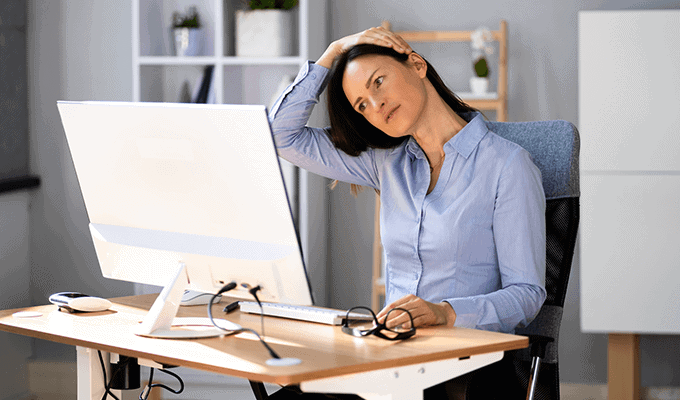
- Minimal postural deformities: Regular head and shoulder stretches make the spine erect and there is no postural deformity.
- Adequate blood supply to the body: With frequent stretches, there is less inflammation in the body, a boost in metabolism and normal heart function. This ensures adequate blood supply to the body even at rest.
- Toned muscle: The leg stretches help to maintain the muscle cell number and size. It might even lead to an increase in muscle mass.
- Healthy spine: Erect spine means there is no friction and abrasion in the vertebrae. The spinal fluid does not dry and the nerves in the spine do not entangle one another.
- Strong bones: Regular stretches lead to ample deposition of calcium to the bones making the bones strong. With exercise, vitamin D works better and strengthens the bones.
- Good eyesight: Eye exercises ensure less strain on eye nerves and muscles. There is a good blood supply to the eyes making the eyesight strong.
Conclusion
These quick and simple exercises & stretches to do at the office should be performed every hour. It is difficult to perform all these stretches at the same time; so for each hour, you can target one part of your body. If you are looking to organise fitness sessions in your office to boost your employees’ productivity levels, then enquiry now for corporate group training services.

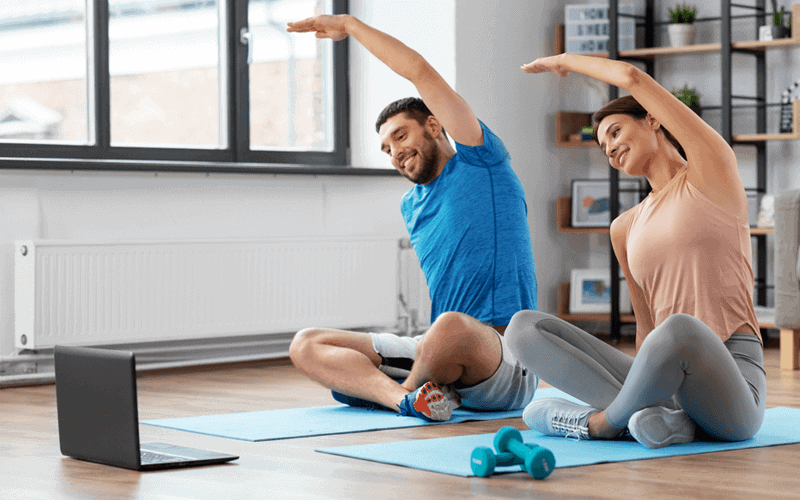
Leave a Reply